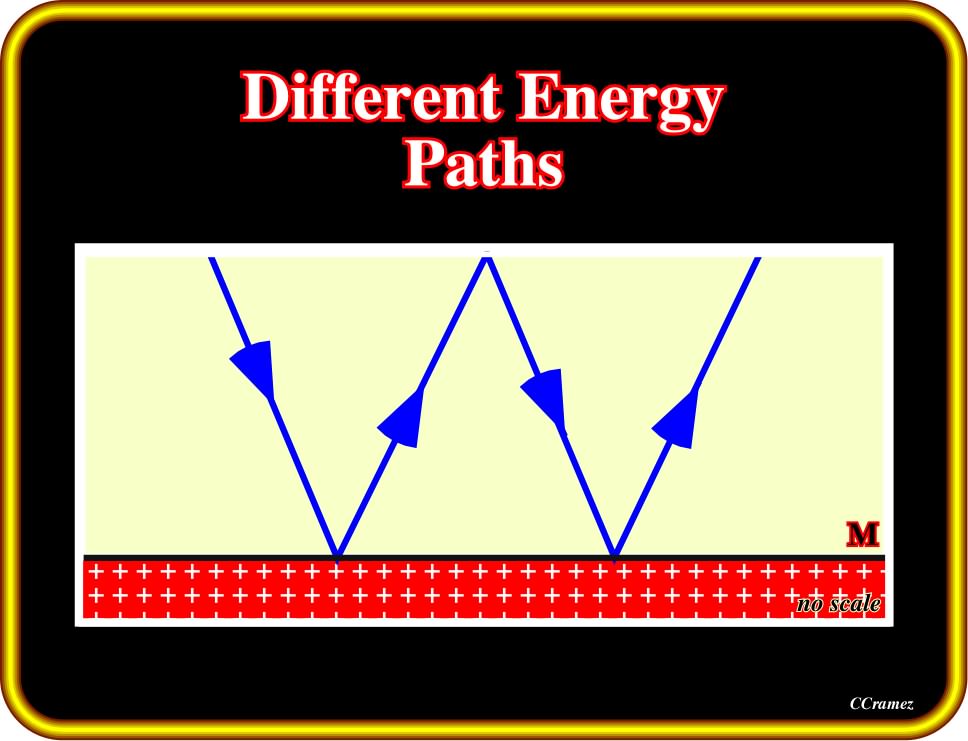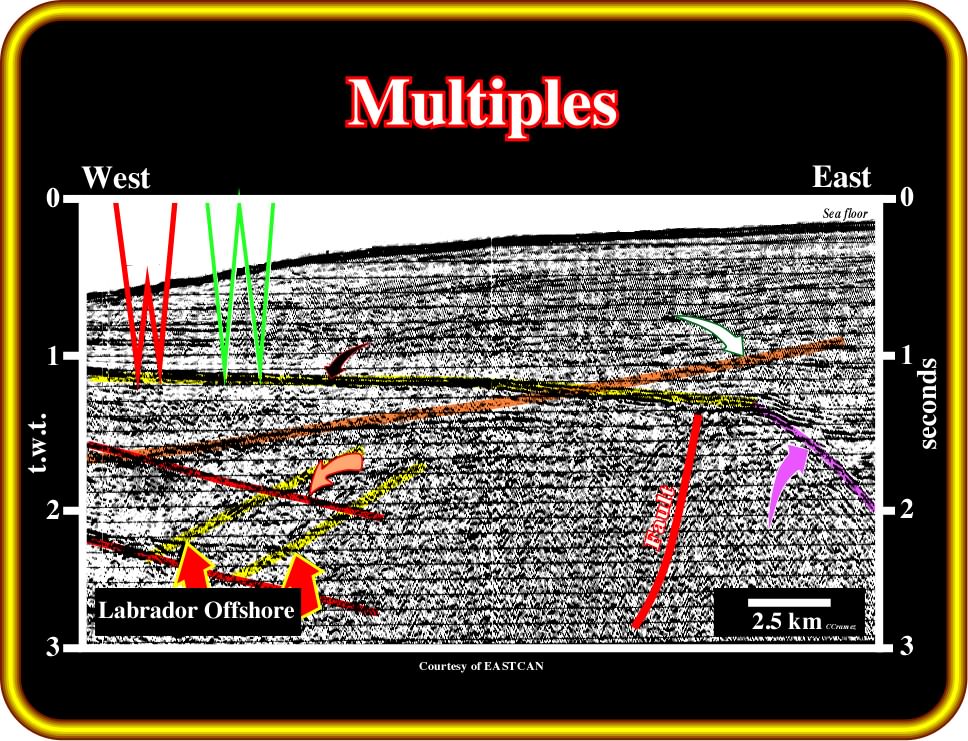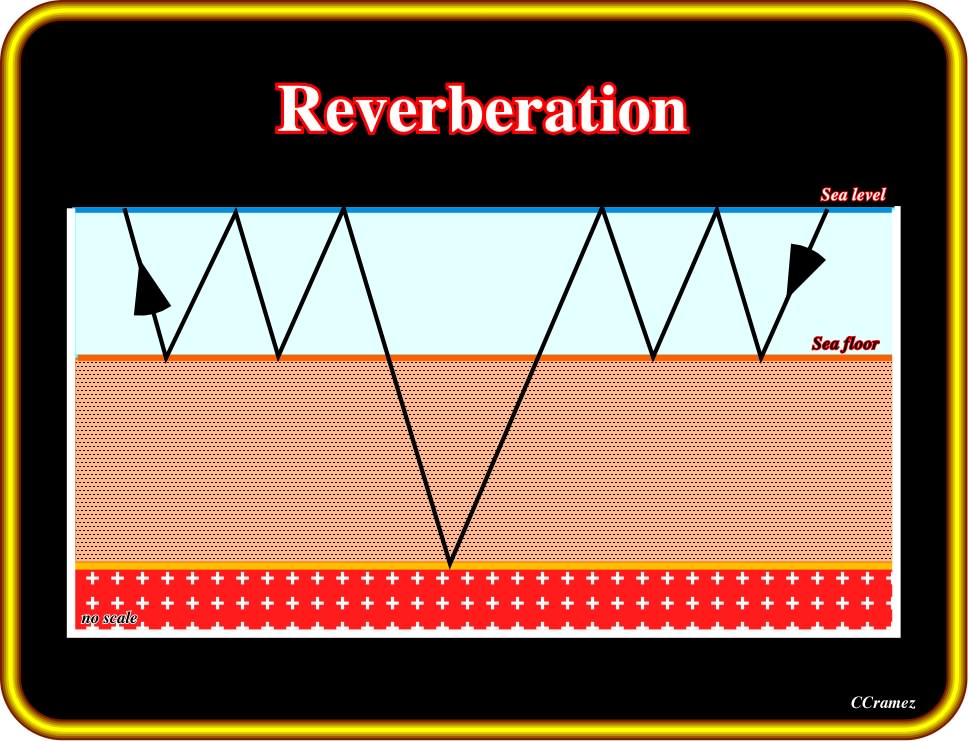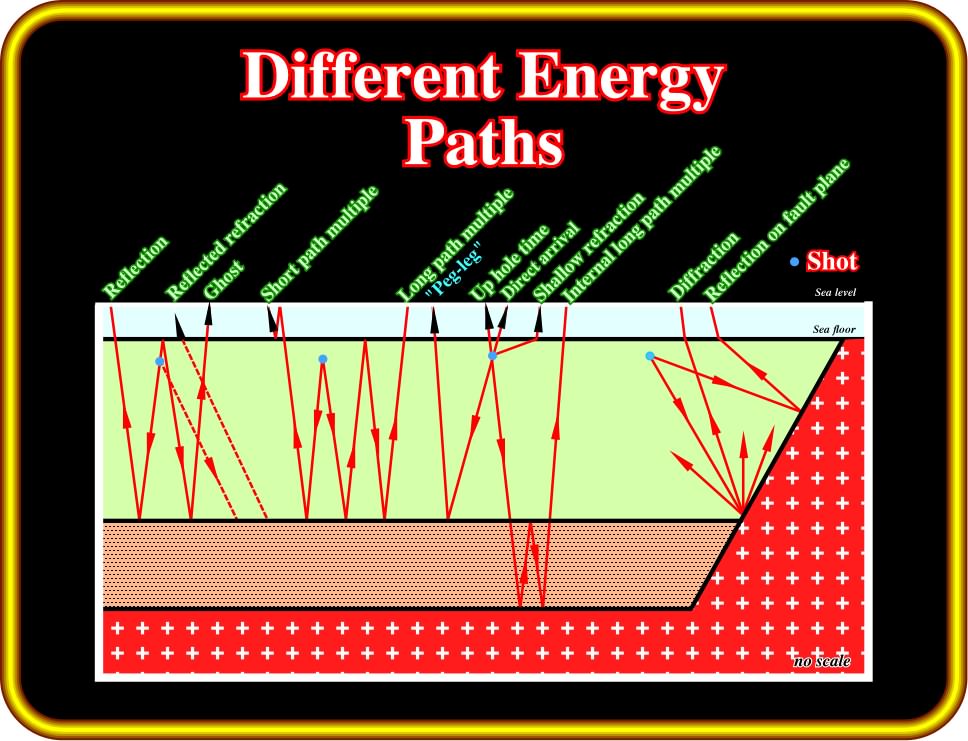

In addition to rays that return to the surface after reflection at single interface, known as primary reflection, there are many paths in a layered subsurface by which rays may return to the surface after reflection at more than one interface (Plate 53). Such rays are called: multiple reflections or simply multiples. These events must be eliminated from the recorded section in order to allow a better understanding of the geology of the area.

Plate 53- Multiply reflected seismic energy or any event in seismic data that has incurred more than one reflection in its travel path is considered a multiple. In this sketch, the primary reflection from the interface M (the first rebound to the left) may be followed by a second arrival. This would be generated by the downward bounce of the residual energy on the upper interface and by its reflection on M. Depending on th time delay from the primary events with which they are associated, multiples are characterized as short-path or peg-leg, implying that they interfere with the primary reflection, or long-path, where they appear as separate events.
Multiples are the principal set of spurious events interfering with seismic data (Plate 54):
Their presence on a recorded section is due to the fact that an acoustic impedance contrast between two adjacent layers, reflects down-going waves up as well as down.

Plate 54- This old seismic line comes from offshore Labrador that is to say an Atlantic-type divergent margin, that, locally, overlies late Cretaceous rift-type basins. Admittedly, this line is affected by numerous multiples. Most of them have higher amplitude than their corresponding primaries. Three successive rebounds within the water layer, if not more, are visible and can be readily accounted for. Several other multiples, however, appear to be generated by the strong dipping horizon at 1 second on the left of the section. Probably, they are secondary rebounds of this primary event: (i) within the water layer ; (ii) downward on the water bottom or (iii) a combination of both. Multiples from the water bottom (the interface of the base of water and the rock or sediment beneath it), as illustrated here, and the air-water interface are common in marine seismic data, but they can be suppressed by seismic processing.
A certain amount of seismic energy, therefore, is not transmitted from one layer to the next through the stratigraphic series along a simple two-way path. It remains trapped within a given formation producing an arrival on the recorded section at each rebound:
(i) Surface multiples (generated by the downward rebound at the air or seaground interface) are the most common :
- They may be readily distinguished from primaries ;
- They appear on the seismic section at double the time of primary reflections.
(ii) Generally, a multiple has weaker amplitude than its primary as most of the reflected energy is in fact transmitted through. However, this is not always the case. If the acoustic impedance contrasts generating multiples are higher than the contrasts generating primary reflectors, for a given time, the spurious events will be stronger on the seismic section.
(iii) Other situations may also occur, such as resonance (tendency of a system to oscillate at a greater amplitude at some frequencies than at others) within a layer or fortuitous summing of a multiple with later primary arrivals within the same frequency range.
The travel path of internal multiples, generated anywhere within the stratigraphic sequence by the trapping of energy within a layer or a combination of layers, is much more difficult to reconstruct.
In water layer reverberations, as sketched in Plate 55, the rays from a marine source are repeatedly reflected at the seabed and sea surface (ringing in water).

Plate 55- The reverberation in water illustrated on this sketch corresponds to persistence of a wave (sound) after its source has stopped, caused by multiple reflection of the wave within a closed space (in this case the water layer). Reverberation is also known as ringing, and defined as seismic resonance produced by short-path multiples in a water layer. As the repeated travel paths within the water layer are summed to the travel time to the indicated deeper horizon, the associated reflections are geologically meaningless and must be eliminated.
This type of multiple (also visible in Plate 54) is, probably, the most annoying but, fortunately, it is the easiest to eliminate. The two interfaces, at either side of the water level, are excellent reflector :
- The air-water acoustic impedance contrast is as effective as the water-sediment contrast.
- Bound by two strong reflecting interfaces, the water layer is an excellent multiple-generating medium. This is particularly true, on hard water-bottom areas where sediments are compacted and well consolidated.
In the example shown below (Plate 56), repeated travel paths, within the water layer, are summed to the travel time to the indicated deeper horizon.

Plate 56- Generally, seismic ringing is due to resonance in a ground layer or water layer. This marine section from offshore Labrador shows several multiples induced by the water layer. A strong reflection, culminating at approximately 2 seconds, is visible in the middle of the section. Because of the high acoustic impedance contrast at the water-bottom, 1st and 2nd order multiples are produced within the water layer (ringing / reverberations). The time difference between the primary and its first multiple is, every where, equal to the time through the water layer.
Each rebound generates successive multiples of this horizon. The marine section illustrated on Plate 56, from offshore Labrador, shows this kind of multiple. In this particular example:
- The multiple reflections have amplitudes comparable with the primary reflections.
- The strong amplitude is due to the high reflection coefficient of the interfaces.
The sketch illustrated on Plate 57 attempts to schematize the most probable paths, between shot point and receiver that an acoustic wave traveling through the sedimentary intervals may chose. Direct primary arrivals and different sets of multiples are shown.

Plate 57 - On this sketch, in which the shots are underground, below the base of weathered layer, from left to right, we can recognize: (i) a reflection ; (ii) a reflection refraction ; (iii) a ghost ; (iv) a short path multiple ; (v) a long path multiple ; (vi) a peg leg multiple ; (vii) an up hole time ; (viii) a direct arrival ; (ix) a shallow refraction ; (x) an internal long path multiple ; (xi) a diffraction and (xii) reflections on a fault plane. As illustrated a peg leg multiple is a type of short-path multiple, or multiply-reflected seismic energy, which has an asymmetric path. Short-path multiples are added to primary reflections, tend to come from shallow subsurface phenomena and highly cyclical deposition, and can be suppressed by seismic processing. In some cases, the period of the peg-leg multiple is so brief that it interferes with primary reflections, and its interference causes a loss of high frequencies in the wavelet (http://www.glossary. oilfield.slb.com/default.cfm). The up-hole travel time for the seismic impulse from a dynamite explosion is usually taken to depend only on charge depth and formation velocity. In practice, the measured travel time is influenced by charge size, by filter setting, by instrument sensitivity, and by previous history of the shot hole. In some areas, there occur anomalous up-hole times which are difficult to explain (http://geophysics.geoscienceworld.org/content/17/2/229.abstract).
The more frequent multiples, that is to say, reflection events having suffered more than one reflection, as illustrated on Plate 57, are:
- Diffraction ;
A radial scattering of incident seismic energy. Diffraction refers to various phenomena which occur when a wave encounters an obstacle. The difference between seismic refraction and seismic reflection is never obvious to the non geophysicist, and rarely explained in simple terms by geophysicists.
- Reflected refraction ;
A refraction along a bedding plane or unconformity (reflectors) with appropriate velocity contrast that is reflected back from steep surfaces. Reflected refractions contain information only about the refractor.
- Ghost ;
A reflection event arriving a short time after the primary from the surface or the base of weathered layer (buried explosion on land).
- Short path multiple ;
A multiple-reflection involving only a short additional path length arriving very soon after the primary event.
- Long path multiple ;
It is a multiple-reflection involving additional path length sufficiently long that it is a distinct and separate event in the seismic record.
- “Peg leg” ;
An assymetric multiple-reflection induced by a ringing between two reflectors.
Send E-mail to carloscramez@gmail.com with questions or comments about these notes (Seismic-Sequential Stratigraphy).
Copyright © 2003 CCramez
Last modification: September, 2014